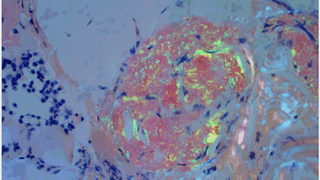AL amyloidosis
Treatment of AL amyloidosis can help reduce symptoms, reduce heart failure-related hospitalization, and improve the length and quality of life.
Treatment plans are tailored to each patient and are based upon disease progression and seriousness of the patient’s organ, tissue, and nerve involvement. Currently, treatment options are focused on reducing the production of light chain protein from the bone marrow; however, newer treatments are in clinical development, such as CAEL-101, a novel antibody that may be able to clear the deposited protein in various organs and promote quicker recovery.
Treatment plans include both supportive treatment and source treatment.
Supportive Treatment
Supportive treatment is helpful for various symptoms, including cardiac and kidney problems, and can make a significant improvement in a patient’s quality of life. Examples include:
- Cardiac medication
- Preserving kidney function
- Symptomatic treatment of neuropathy
- Geriatric assessments
- Psychological support
Reversing any damage to the organs and other parts of the body is difficult to achieve. However, if treatment begins during the early onset of clinical symptoms, the overall success rate is higher, so early detection is essential.
Source Treatment
A bone marrow transplant is often considered the preferred treatment for AL because it can provide long-term control of the underlying disease. However, only a minority of AL patients are eligible.
For the majority of AL amyloidosis patients, other chemotherapy-based treatments are considered. These treatment regimens are tailored for each patient based on organ function, symptoms, and preferences.
Patients with AL amyloidosis have benefited from the development of new drugs for myeloma, many of which work effectively on the plasma cells that cause AL amyloidosis. Often, drug combinations are more effective than single drugs in attacking the abnormal plasma cells. Dosage is tailored to each patient. Categories of drugs that may be used include:
- Traditional chemotherapy drugs: Melphalan, Cyclophosphamide (Cytoxan™), Bendamustine (Treanda™)
- Proteasome inhibitors: Bortezomib (Velcade™), MLN9708 (Ixazomib™), Carfilzomib (Kyprolis™)
- Immunomodulators: Thalidomide (Thalidomid™), Lenalidomide (Revlimid™), Pomalidomide (Pomalyst™).
- Monoclonal antibodies: daratumumab (Darzalex)
Some of these drugs are still considered investigational for AL amyloidosis and should not be used outside of a sponsored clinical trial. Most of them are given with a steroid, such as dexamethasone, which seems to increase their effectiveness.











